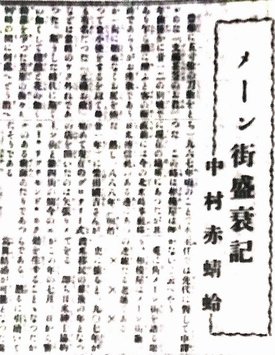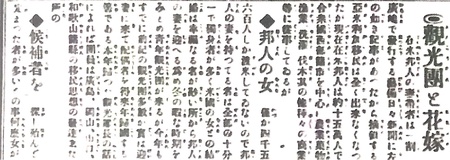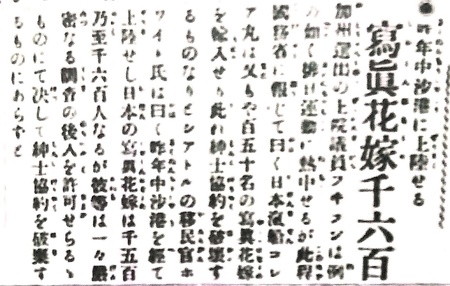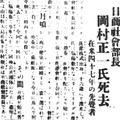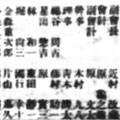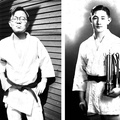The last chapter reviewed the history of The North American Times. In this chapter, I will introduce articles from 1918 to about 1920 on marriage through picture brides which peaked around 1910.
Beginning about 1900, the anti-Japanese movement in America began to get intense. In response, the Japanese government concluded the Gentlemen’s Agreement with the U.S. in 1908. This agreement imposed restrictions on Japanese immigration to America. Since it also made it difficult for Japanese workers in America to return temporarily to Japan, the number of “picture brides” — those that got married through the exchange of pictures without first meeting the other party — increased rapidly. Many Nisei were born as a result of these arranged marriages.
ON PICTURE-BRIDE MARRIAGES
Akatonbo Nakamura discusses picture-bride marriages in the column “The Rise and Fall of Main Street” in The North American Times on Jan. 1, 1939.
“The year 1907 became the last year of Japanese immigration to the U.S. This is because the Gentlemen’s Agreement was enforced as of July 1 of that year. Following its enforcement, picture marriages were still possible. The Smith Cove Terminal witnessed both tragic and comedic scenes in various situations, as ships carried brides one after another, beginning in 1908.
Brides filling the ship gathered at the departure desk and looked at the crowd on the wharf, checking small pictures in their pockets, all seemingly at the same time. As for the grooms who had come to the wharf to welcome their brides, they also looked in their pockets, searching for their matches among the crowd of brides on the deck. This scene gave me such a sentiment which I could not quite explain. Some fainted as they faced each other and some grooms ran away the moment they recognized their brides, leaving the brides, who had crossed the 4,000-mile route of waves, alone there….
The brides arriving in America became a turning point for single men whose work life developed into the so-called family life, leading them to settle down.”
“What Is a Picture Bride?—Picture Marriages from the Caucasian Perspective” (July 31, 1919 issue)
“One newspaper in the U.S. asks what a picture bride is and gives its own definition. I’d like to explain how such marriage was perceived by foreigners, just for reference. The words “Japanese picture bride” are quite ordinary on their own, but few people know what the process is like. This is how it’s done.
When a Japanese man in Seattle wishes to marry a woman in Japan but does not intend to go back to Japan himself, he will entrust the marriage to someone else. For example, he will ask his friend, who is in Japan, to complete the marriage documents with her on his behalf. Once they get 'married,' they will attach a picture of the bride to her passport. Immigration officers in Japan will then check this and let the bride board the ship. On her arrival in Seattle, she will be detained at the immigration bureau and passed onto her husband, who has committed to the marriage.
Very few Japanese women enter the country in other ways. While the immigration bureau wants to prevent more Asian immigrants from entering regardless of gender, there is nothing they can do because of the institution of picture brides.”
ARGUMENTS FOR AND AGAINST PICTURE MARRIAGE
As picture marriage was “approved” by the Gentlemen’s Agreement, the number of picture brides increased rapidly in the 1910s. People had many different opinions, both arguing for and against it. The North American Times published an excerpt of an article from a local paper in Hiroshima, Geibi Nichinichi Shimbun, to introduce how the marriage of single men in America was perceived in Japan.
“Tourist Parties and Brides” (May 9, 1919 issue)
“Immigration to America is no longer possible. Today there are about 150,000 Japanese residents in America, engaged in businesses such as agriculture, growing fruits, fisheries, laundry, logging, and some other work mostly in western cities in the U.S. Only about 4500 to 4600 Japanese women have migrated to the U.S.; so one in ten men has a Japanese wife, leaving many unmarried. Since there is a slight chance of finding happiness in marriages with American women, many would visit Japan in the form of tourist groups during winter, when they are less busy with work, with their true purpose being to find spouses.
One leader of a tourist group who went to Japan this year said that the group members looked for spouses in places where people have positive views on immigration such as Hiroshima, Okayama, Yamaguchi and Wakayama, and most of them did find wives. From the women’s side, they decided to go because they were divorced or past marriageable age. Some made the decision out of vanity, as they heard about others in neighboring villages who had moved to America sending money to their parents every month or had built a storehouse (“kura,” a traditional fireproof stone house next door to one’s wooden residence, used for storing valuables).
Some might do it because they don’t want to marry in Japan, where they have to deal with a mother-in-law or sister-in-law. There are some, though this is very rare, who wish to gain skills such as machine embroidery. Seventy to 80 percent of them have some “problem.” Because it costs a lot to prepare for marriage in Japan these days, some parents accept the proposals from the U.S. where they won’t be required to get Japanese (traditional) attire ready. People like these are the progressive ones. As the public has learned the cons of picture marriage in recent years, few women are willing to say yes when the men themselves do not come; when proposing through a picture, brides might fulfill only half of what men ask for in a bride. Women rarely choose to get married that way unless they look like they are from outer space or something.”
“1,600 Picture Brides Landed in Seattle Last Year” (July 28, 1919 issue)
“According to a report of the Department of State, California Senator Ferguson (Hiram Johnson, R?) is ardently engaged in the anti-Japanese movement. The Japanese steamship Korea-maru brought another 150 picture brides there, in possible violation of the Gentlemen’s Agreement.
The Immigration Officer in Seattle, White, comments as follows: About 1,500 to 1,600 picture brides from Japan arrived in Seattle last year. They have all been through strict examination and have been permitted to enter, so this doesn’t violate the Gentlemen’s Agreement.”
ARGUMENTS FOR AND AGAINST MARRIAGE THROUGH PICTURE BRIDES
Shikako Takatani, a female writer of The North American Times who appeared previously in this series (Chapter 10 - part 3), wrote a commentary on picture-bride marriages.
“Determination of Picture-Bride Wives in America” (Jan. 1, 1920 issue)
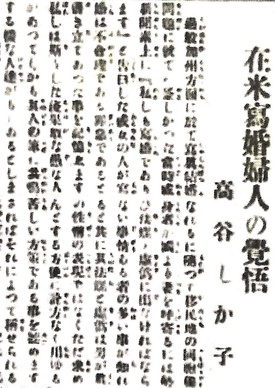 Shikako Takatani “Determination of Picture Married Women in America” (The North American Times, January 1, 1920)
Shikako Takatani “Determination of Picture Married Women in America” (The North American Times, January 1, 1920)“Under the current marriage situation in Japan, it is common that two parties get married without knowing anything about each other, as their parents choose spouses for them, or they get married after having met just once in person. Picture marriages fall under the category of arranged marriage. Two parties exchange their pictures and letters of love as people in the old days might have done, whispering the words of love under the moonlight or in the shade of flowers – this is rather self-motivating and rational for the Japanese…
For you ladies who got married as picture brides, you didn’t have time to think about yourself or agonize and grieve over the stupidity of whatever you think is making you suffer. The weak and meek women who were kept under control in the feudal era have now been set free, to live their lives on equal terms with men. You shouldn’t let yourself be a whining one under the pressure of some strong force, like a puppy barking and running away in fear of the legs of a big elephant. We must be the strong women like the ones in films, the fat wife that kicks the butt of her husband to send him off to work…
Those out there are now throwing the hammer called “exclusion” up in the air. We have to watch over our husbands and kids who walk under it, from inside the windows quietly and carefully.”
*The English version of this series is a collaboration between Discover Nikkei and The North American Post, Seattle’s bilingual community newspaper. This article was originally publishd on October 21 and November 20, 2022 in The North American Post and is modified for Discover Nikkei.
© 2022 Ikuo Shinmasu


